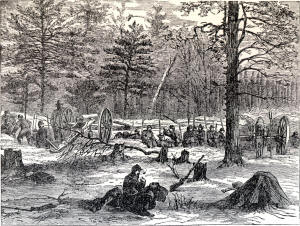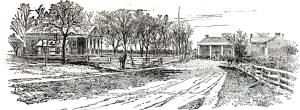|
This Site:
Civil War
Civil War Overview
Civil War 1861
Civil War 1862
Civil War 1863
Civil War 1864
Civil War 1865
Civil War Battles
Confederate Generals
Union Generals
Confederate History
Robert E. Lee
Civil War Medicine
Lincoln Assassination
Slavery
Site Search
Civil War Links
Civil War Art
Revolutionary War
Mexican War
Republic of Texas
Indians
Winslow Homer
Thomas Nast
Mathew Brady
Western Art
Civil War Gifts
Robert E. Lee Portrait
|
|
Spotsylvania
Court-house, BATTLE OF.
Robert E. Lee was evidently satisfied, at the close of the
battle of the Wilderness in 1864, that
he could not maintain a further contest with
Grant on the ground he (Lee)
had chosen, so he retired beyond entrenchments, where he was found standing
on the defensive by the skirmish line of the Nationals, sent out at daybreak
on Saturday morning, May 7. There had been sharp skirmishing the day before.
A charge had been made on
Hancock's corps, when 700 of his cavalry were
captured. |

SCENE OF SEDGWICK'S DEATH.
|
Grant had no desire to renew the conflict there, and after dark that night
he put his army in motion towards Spotsylvania Courthouse, 15 miles
southeast from the battlefield. Warren and Sedgwick took the direct route by
the Brock road, and Hancock and
Burnside, with the trains, by a road farther
east. The march was slow, for many obstaclesósuch as felled trees and
opposing troopsówere in the way. Lee
had anticipated Grant's movement, and was pushing on by a parallel road
towards the same destination. His advance, under General Anderson, continued
the march all night, and reached the vicinity of Spotsylvania Courthouse and
entrenched before Warren came up. By the evening of the 8th
Robert E. Lee's whole force was
entrenched on a ridge around Spotsylvania Courthouse, facing north and east.
The following day was spent by Grant in making dispositions for attack, and
by Lee in strengthening his
position. There had been sharp fighting the day before (May 8) between
Warren and a force of the Confederates. Warren held his position until
relief arrived from Sedgwick, when the Confederates were repulsed. The
Nationals lost about 1,300 men. The commanders of several regiments fell.
One Michigan regiment went into battle with 200 men, and came out with 23.
The day was intensely hot, and many suffered from sunstroke. Monday, the
9th, was comparatively quiet in the morning. There was skirmishing nearly
all day. In the afternoon General Sedgwick was killed by the bullet of a
sharpshooter while superintending the planting of cannon on a redoubt, and
his command of the 6th Corps devolved on Gen. H. G. Wright. Towards night
Grant ordered another advance on the Confederates. The divisions of Gibbon
and Birney, of Hancock's corps, crossed a branch of the Po River, and had a
severe struggle. Hancock attempted to capture a wagon train. He had made a
lodgment with three divisions, and was pushing forward, when he was recalled
for other service. On his return he was attacked, and lost heavily. The
woods between a part of his troops and the river had taken fire, and many of
his men perished in the flames.
That night Lee's army occupied
Spotsylvania Courthouse, and stood squarely across the path of the intended
march of the Army of the Potomac towards Richmond. Everything was in
readiness for battle on the morning of the 10th. The main attack by the
Nationals was against Lee's left
center, strongly entrenched on Laurel Hill, wooded, and surrounded by a
dense growth of cedar. It was the strongest point in the Confederate line.
In two attacks the Nationals were repulsed with heavy loss. At 5 P.M. the
2nd and 5th Corps moved to the attack. The conflict was fearful, and the
Nationals were repulsed. The assault was repeated an hour later, with a
similar result. In the two attacks, nearly 6,000 Unionists had fallen, while
not more than 600 of the Confederates had been disabled. |
|
The enterprise was abandoned. Farther to the left, a
portion of the 6th Corps carried the first line of the Confederate
entrenchments, and captured 900 prisoners and several guns. Then the first
day's real battle at Spotsylvania Courthouse was ended. |

SPOTSYLVANIA COURT-HOUSE.
|
|
On the morning of the 11th Grant wrote to the Secretary of War: " We have
now ended the sixth day of very heavy fighting. The result to this time is
much in our favor. Our losses have been heavy, as well as those of the
enemy. I think those of the enemy must be greater. We have taken over 5,000
prisoners by battle, while he has taken from us but few, except stragglers.
I propose to fight it out on this line, if it takes all summer." The 11th
was mostly spent in preparing for another battle. Grant determined to strike
Lee's right center where it appeared
most vulnerable. The night was very dark and stormy. He moved at midnight,
and Hancock took a position within 1,200 yards of the Confederate line. He
stormed it at 4 A.M. on the 12th. He burst through the lines, and, after a
hand-to-hand conflict inside the trenches, captured 4,000 men, and drove his
adversaries through the woods towards the village. At the second line of
entrenchments Hancock's men, having lost their organization, were forced to
retire to the first, which they held with the aid of the 6th Corps. Five
times during the day Robert E. Lee
attempted to dislodge Hancock, but was repulsed each time, with heavy loss.
So fierce had been the battle that one-half of the forest within range of
the musketry was destroyed by bullet wounds. A tree 18 inches in diameter was
entirely cut in two by musket balls. The scene of the engagement was
afterwards known as " the field of the bloody angle." |
|
Meanwhile Burnside, on the left, and Warren, on the
right, had made attacks on Lee's
wings, but were repulsed. At midnight
Robert El Lee withdrew to his second line, and Hancock finally held the
works he had captured in the morning, with twenty-two guns. So ended the
battle of Spotsylvania Court-house. |

THE FIELD OF THE BLOODY ANGLE. |
The official report of the
National losses, from the crossing of the Rapidan (May 4) to the close of
the battle on May 12, gave a total of 29,410 men; of whom 269 officers and
3,019 enlisted men were killed, and nearly 7,000 had been made prisoners.
See THE BATTLE OF WILDERNESS. |
|


